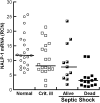Inflammasome mRNA expression in human monocytes during early septic shock
- PMID: 18263805
- PMCID: PMC2361424
- DOI: 10.1164/rccm.200703-418OC
Inflammasome mRNA expression in human monocytes during early septic shock
Abstract
Rationale: Monocytes are central to the initiation of the inflammatory response in sepsis, with caspase-1 activation playing a key role. Monocyte deactivation during sepsis has been linked to poor outcomes.
Objectives: Given the importance of caspase-1 in the immune response, we investigated whether monocytes from patients early in septic shock demonstrate alterations in mRNAs for caspase-1-related molecules.
Methods: Patients with septic shock (n = 26; age >18 years), critically ill intensive care unit patients (n = 20), and healthy volunteers (n = 22) were enrolled in a prospective cohort study in a university intensive care unit. Demographic, biological, physiologic, and plasma cytokine measurements were obtained. Monocytes were assayed for ex vivo tumor necrosis factor-alpha production, and fresh monocyte mRNA was analyzed by quantitative reverse-transcription polymerase chain reaction for Toll-like receptors, NOD-LRR proteins, cytokines, and nuclear factor-kappaB-related genes.
Measurements and main results: Relative copy numbers for the inflammasome mRNAs for ASC, caspase-1, NALP1, and Pypaf-7 were significantly lower in patients with septic shock compared with critically ill control subjects. NALP1 mRNA levels were linked to survival in patients with sepsis (P = 0.0068) and correlated with SAPS II scores (r = -0.63).
Conclusions: These data suggest that monocyte deactivation occurs during the earliest stages of the systemic inflammatory response and that changes in inflammasome mRNA expression are part of this process.
Figures

References
-
- Anderson RN, Smith BL. Deaths: leading causes for 2002. Natl Vital Stat Rep 2005;53:1–89. - PubMed
-
- Bone RC. Toward a theory regarding the pathogenesis of the systemic inflammatory response syndrome: what we do and do not know about cytokine regulation. Crit Care Med 1996;24:163–172. - PubMed
-
- Bone RC. Immunologic dissonance: a continuing evolution in our understanding of the systemic inflammatory response syndrome (SIRS) and the multiple organ dysfunction syndrome (MODS). Ann Intern Med 1996;125:680–687. - PubMed
-
- Thijs LG, Hack CE. Time course of cytokine levels in sepsis. Intensive Care Med 1995;21:S258–S263. - PubMed
-
- Damas P, Reuter A, Gysen P, Demonty J, Lamy M, Franchimont P. Tumor necrosis factor and interleukin-1 serum levels during severe sepsis in humans. Crit Care Med 1989;17:975–978. - PubMed
Publication types
MeSH terms
Substances
Grants and funding
LinkOut - more resources
Full Text Sources
Other Literature Sources
Miscellaneous

